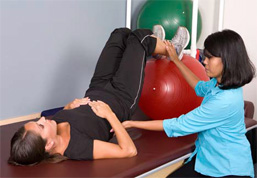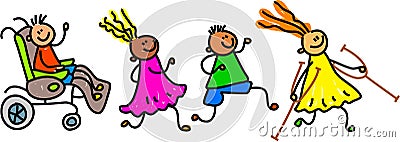Medical Intervention
 Children who have multiple or severe disabilities, could sometimes be considered the greatest candidates for various types of medical intervention. It is very difficult to go into detail on every procedure and implant a child may have to endure or adapt to. Physicians and parents work together to decide the best procedure to make the child comfortable, happy, as independent as possible and able to communicate. Sometimes medical intervention can be a cochlear implant for a child who may have a hearing impairment, other times it involves a long serious of life long tests and/surgeries. Children who require these kinds of medical interventions who seem fragile to the naked eye, just might be the strongest of us all.
Children who have multiple or severe disabilities, could sometimes be considered the greatest candidates for various types of medical intervention. It is very difficult to go into detail on every procedure and implant a child may have to endure or adapt to. Physicians and parents work together to decide the best procedure to make the child comfortable, happy, as independent as possible and able to communicate. Sometimes medical intervention can be a cochlear implant for a child who may have a hearing impairment, other times it involves a long serious of life long tests and/surgeries. Children who require these kinds of medical interventions who seem fragile to the naked eye, just might be the strongest of us all.
Medical intervention for children with severe and multiple disabilities may include:
-drug therapy
- life saving treatment
-support therapy (Winzer)
 This is a video of one way that medical intervention is changing the world for children with multiple disabilities. This child in the video has been diagnosed as being legally blind and having a hearing impairment. This situation could inhibit this girl’s interaction and communication with others. Thanks to one kind of medical intervention she is now able to hear, opening up windows of communication that might have been nearly impossible for her before. https://www.youtube.com/watch?v=OuBoN7E1bdc
This is a video of one way that medical intervention is changing the world for children with multiple disabilities. This child in the video has been diagnosed as being legally blind and having a hearing impairment. This situation could inhibit this girl’s interaction and communication with others. Thanks to one kind of medical intervention she is now able to hear, opening up windows of communication that might have been nearly impossible for her before. https://www.youtube.com/watch?v=OuBoN7E1bdc
 Children who have multiple or severe disabilities, could sometimes be considered the greatest candidates for various types of medical intervention. It is very difficult to go into detail on every procedure and implant a child may have to endure or adapt to. Physicians and parents work together to decide the best procedure to make the child comfortable, happy, as independent as possible and able to communicate. Sometimes medical intervention can be a cochlear implant for a child who may have a hearing impairment, other times it involves a long serious of life long tests and/surgeries. Children who require these kinds of medical interventions who seem fragile to the naked eye, just might be the strongest of us all.
Children who have multiple or severe disabilities, could sometimes be considered the greatest candidates for various types of medical intervention. It is very difficult to go into detail on every procedure and implant a child may have to endure or adapt to. Physicians and parents work together to decide the best procedure to make the child comfortable, happy, as independent as possible and able to communicate. Sometimes medical intervention can be a cochlear implant for a child who may have a hearing impairment, other times it involves a long serious of life long tests and/surgeries. Children who require these kinds of medical interventions who seem fragile to the naked eye, just might be the strongest of us all. Medical intervention for children with severe and multiple disabilities may include:
-drug therapy
- life saving treatment
-support therapy (Winzer)
 This is a video of one way that medical intervention is changing the world for children with multiple disabilities. This child in the video has been diagnosed as being legally blind and having a hearing impairment. This situation could inhibit this girl’s interaction and communication with others. Thanks to one kind of medical intervention she is now able to hear, opening up windows of communication that might have been nearly impossible for her before. https://www.youtube.com/watch?v=OuBoN7E1bdc
This is a video of one way that medical intervention is changing the world for children with multiple disabilities. This child in the video has been diagnosed as being legally blind and having a hearing impairment. This situation could inhibit this girl’s interaction and communication with others. Thanks to one kind of medical intervention she is now able to hear, opening up windows of communication that might have been nearly impossible for her before. https://www.youtube.com/watch?v=OuBoN7E1bdc
One form of medical intervention for persons with severe or multiple disabilities is to be provided with the right medical information for their needs. People with severe or multiple disabilities may need their care takers to, with them attend information sessions on proper health care. For example: nutritional courses for those who are wheelchair dependent might be beneficial. (Williams)
Wheelchair users face day-to-day difficulties that When we think about medical intervention we think about some of the great advances we have made in order to help people to communicate and become involved. Sometimes medical intervention helps people to live longer stronger lives.
Sadly sometimes medical intervention is used in the opposite way however. Many in the medical field are helping people with severe and multiple disabilities to interact, communicate and to achieve better physical mobility. On the other hand there are those who perhaps do not understand what ‘quality of life’ might mean. “Many people with disabilities have found satisfaction in their lives that was far greater than anything expected of them by members of the health and rehabilitation professions” (Asch).

Unfortunately people with a disability may loose their rights and dignity when it comes to medical intervention. For example: in 2006 a nine year old girl from Seattle who had been diagnosed with

The following article Disability, Bioethics, and Human Rights written by Adrienne Asch a bioethics professor breaks down the relationships between disabilities, bioethics and human rights. The paper goes into detail on how the three cross over as well as the misunderstandings between the medical field and the people whom they are treating.
Educational Intervention

For children who have sever or multiple disabilities attitude is the most critical factor related to the success of students in the classroom
When students join the classroom, educational assistants may read the cumulative file or talk to the parents about the medical history of the students
If is taking the medicine the educational assistant should find out what it is, how it works and what any side effects might be
You should allow the student extra time to process language and respond if needed
try to always keep regular schedules, routines and school rules clear for the students.
When communicating with the student always use clear language
Try to break the tasks into smaller steps and explain the each step individually
Use pictures, symbols or signs to communicate with the student when it is helpful for them
If the students multiple disability includes a vision impairment then allow the student to sit in the front of the classroom
If you are writing any material on the board then you can also provide the same information in large type written format
Try to use an overhead projector instead of whiteboard, this way you can highlight the information using different colors for students who may find this helpful
While you are speaking the student who may have a hearing impairment do not put your hands in front of your face
Always provide extra time for tests and quizzes, because sometimes the student may depend on their intervener
For student who may have sever or multiple disabilities there are some general steps which you can follow:
When students join the classroom, educational assistants may read the cumulative file or talk to the parents about the medical history of the students
If is taking the medicine the educational assistant should find out what it is, how it works and what any side effects might be
You should allow the student extra time to process language and respond if needed
try to always keep regular schedules, routines and school rules clear for the students.
When communicating with the student always use clear language
Try to break the tasks into smaller steps and explain the each step individually
Use pictures, symbols or signs to communicate with the student when it is helpful for them
If the students multiple disability includes a vision impairment then allow the student to sit in the front of the classroom
If you are writing any material on the board then you can also provide the same information in large type written format
Try to use an overhead projector instead of whiteboard, this way you can highlight the information using different colors for students who may find this helpful
While you are speaking the student who may have a hearing impairment do not put your hands in front of your face
Always provide extra time for tests and quizzes, because sometimes the student may depend on their intervener
For student who may have sever or multiple disabilities there are some general steps which you can follow:
1) Be patient and calm all the time
2) Try to repeat the information if student needs it to be repeated again
3) Choose the best strategy which is suitable for that student
Therapeutic Intervention

Physical therapy
A physical doctor can help children, teenagers and adults achieve a more comfortable state of health.
Physical therapy for children with severe and multiple disabilities can help with the muscle plans and gross motor development.
Physical therapy for children with severe and multiple disabilities can help with the muscle plans and gross motor development.
Occupational therapy: Explained including severe disabilities
http://www.youtube.com/watch?v=D1OCGrcRKQY
Deafblind Therapy
In September of 1971, W. Ross Mac Donald opened the doors to people with hearing and vision impairments. When opened, the program only started with seven children. That number grew more and more as the years went on. All the people who helped out in the program were teachers or volunteers. Today, teachers who finish university can take a special course at The George Brown University and graduate as a “Deafblind Specialist Teacher.”
Resources
Children with exceptionalities in Canadian classrooms, Margret Winzer 2010 Retrieved from: http://wps.pearsoned.ca/ca_ph_winzer_children_8/66/16943/4337612.cw/index.html
Brunner & Suddarth's Textbook of Canadian Medical-surgical Nursing Pauline Paul, Beverly Williams Retrieved from: http://books.google.ca/books?id=SB_-CRXvZPYC&pg=PA185&lpg=PA185&dq=canadian+%22medical+intervention%22+severe+disabilities&source=bl&ots=LQs4W8piH_&sig=0yzXuID0_Z8gojKwfV_6EHASrLw&hl=en&sa=X&ei=0srzUpa9CaXhyQHciIGQCw&ved=0CCsQ6AEwAA#v=onepage&q=canadian%20%22medical%20intervention%22%20severe%20disabilities&f=false
L'Arche Canada, 2010 Retrieved from: http://wcr.ab.ca/old-site/news/2007/0129/ashley012907.shtml
http://56c2011.global2.vic.edu.au/tag/agenda/
http://56c2011.global2.vic.edu.au/tag/agenda/


I find it hard to imagine what the parents of a child with a severe and multiple disability must go through. Through reading the "Ashley therapy" it is a position that must be full of torment, and not an easy decision at all. I really liked your educational interventions section, very informative and useful. Thanks guys
ReplyDelete